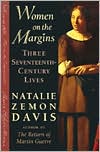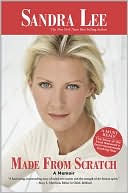Women on the Margins: Three Seventeenth-Century Lives
As she did with Martin Guerre, Natalie Zemon Davis here retrieves individual lives from historical obscurity to give us a window onto the early modern world. As women living in the seventeenth century, Glikl bas Judah Leib, Marie de l'Incarnation, and Maria Sibylla Merian, equally remarkable though very different, were not queens or noblewomen, their every move publicly noted. Rather, they were living "on the margins" in seventeenth-century Europe, North America, and South America. Yet these...
Search in google:
As she did with Martin Guerre, Natalie Zemon Davis here retrieves individual lives from historical obscurity to give us a window onto the early modern world. As women living in the seventeenth century, Glikl bas Judah Leib, Marie de l'Incarnation, and Maria Sibylla Merian, equally remarkable though very different, were not queens or noblewomen, their every move publicly noted. Rather, they were living "on the margins" in seventeenth-century Europe, North America, and South America. Yet these women—one Jewish, one Catholic, one Protestant—left behind memoirs and writings that make for a spellbinding tale and that, in Davis' deft narrative, tell us more about the life of early modern Europe than many an official history.All these women were originally city folk. Glikl bas Judah Leib was a merchant of Hamburg and Metz whose Yiddish autobiography blends folktales with anecdotes about her two marriages, her twelve children, and her business. Marie de l'Incarnation, widowed young, became a mystic visionary among the Ursuline sisters and cofounder of the first Christian school for Amerindian women in North America. Her letters are a rich source of information about the Huron, Algonquin, Montagnais, and Iroquois peoples of Quebec. Maria Sibylla Merian, a German painter and naturalist, produced an innovative work on tropical insects based on lore she gathered from the Carib, Arawak, and African women of Suriname. Along the way she abandoned her husband to join a radical Protestant sect in the Netherlands.Drawing on Glikl's memoirs, Marie's autobiography and correspondence, and Maria's writings on entomology and botany, Davis brings these women to vibrant life. She reconstructs the divergent paths their stories took, and at the same time shows us each amid the common challenges and influences of the time—childrearing, religion, an outpouring of vernacular literature—and in relation to men.The resulting triptych suggests the range of experience, self-consciousness, and expression possible in seventeenth-century Europe and its outposts. It also shows how persons removed from the centers of power and learning ventured in novel directions, modifying in their own way Europe's troubled and ambivalent relations with other "marginal" peoples. Christine Adams - Journal of Social History Davis, with customary virtuosity, explores the lives of Glikl bas Judah Leib, a Jewish merchant woman; Marie Guyart, known as Marie de l'Incarnation, mystic and co-founder of the first Ursuline school for girls in North America; and Maria Sibylla Merian, an artist-naturalist and author...Davis was aided in her efforts to bring these women to life through an abundant variety of source material...[She] adds to these sources, as she did in The Return of Martin Guerre, by plumbing the archives--but also by bringing her own extensive historical knowledge and imagination to this work. The result is a richly textured treatment of the lives and times of each of these women...All three women are fascinating, and Davis offers a creative and compelling look at her subjects...[A] rich and original book...Clearly, these women had an impact in their worlds, and their stories are well worth reading today.
PrologueArguing with GodGlikl bas Judah LeibNew WorldsMarie de l'IncarnationMetamorphosesMarie Sibylla MerianConclusionNotesIllustration CreditsAcknowledgmentsIndex
\ Canadian Journal of HistoryThis erudite and audacious book, like its subjects, occupies margins. Not only is it about women, a subject that a quarter century after Davis and Jill Conway created their justly renowned undergraduate course at the University of Toronto is still at the margins of most university instruction, it also appeals simultaneously to popular and academic audiences; it explores a little used genre of 'comparative biography', it crosses disciplinary boundaries; and perhaps most controversially, it challenges traditional categories of historical proof.\ \ \ \ \ \ Christian Science MonitorA treasure. Davis has written a scholarly...and multilayered history...Her three subjects come alive.\ — Ruth Johnstone Wales\ \ \ \ ForwardMs. Davis accomplishes a kind of intellectual midwifery, expanding our understanding of European and American, women's and Jewish history. Her research findings are artfully woven into the fabric of three narratives, enhancing their ability to successfully transport the reader into a confrontation with the mind-sets of earlier times. She also gives today's readers heroic role models; these are women who rose above constricting circumstances. Detailed evidence of intelligence, resilience and determination make these stories radiant and inspiring, despite the grim events which often saddened and frustrated the women who lived them...A thoughtful, compelling narrative, distinguished by rich details and a passionately empathetic historical imagination.\ — Sylvia Barack Fishman\ \ \ \ \ \ GuardianDavis's finely wrought book works as a triptych; each life is closely observed, but thrown into relief by its relation to the others.\ — Ben Rogers\ \ \ \ \ \ History TodayNatalie Davis tells a good story, as those who have read her classic, The Return of Martin Guerre, will know...Here she tells three good stories.\ — William Lamont\ \ \ \ \ \ History Workshop JournalThrough intimate studies of three seventeenth-century women, [Natalie Zemon Davis] reconstructs histories that both fill out the conceptual frameworks of early modern women's history, and challenge them...One of the great values of Davis's work is the precision with which it tracks its subjects through the multiple domains of their lives: from convent to new frontier, from home to marketplace, from the field to the drawing board...Their lives, as reconstructed through Davis's meticulous and compelling narrative, also shed light on a whole range of social, spiritual and cultural worlds for women, marginalized from much historical narrative...It ends by unsettling the most obvious frameworks for early modern women's history—the household, the workshop, the church—and by demanding historical space for the explorations, the reflections, and the ordinary physical experiences of its subjects.\ — Laura Gowing\ \ \ \ \ \ Independent on SundayA deeply committed but also pleasantly discursive history of women living on the fringes of Europe's early modern culture.\ — Robin Blake\ \ \ \ \ \ Jerusalem Post Literary SupplementDavis has a rare talent: she is both an accomplished historian and a capable writer. While she remains true to her discipline as a historian, she retells Glickl's entertaining didactic stories and recounts the adventures of Marie and Maria in vivid and appealing language.\ — Leslie Cohen\ \ \ \ \ \ Journal of Social HistoryDavis, with customary virtuosity, explores the lives of Glikl bas Judah Leib, a Jewish merchant woman; Marie Guyart, known as Marie de l'Incarnation, mystic and co-founder of the first Ursuline school for girls in North America; and Maria Sibylla Merian, an artist-naturalist and author...Davis was aided in her efforts to bring these women to life through an abundant variety of source material...[She] adds to these sources, as she did in The Return of Martin Guerre, by plumbing the archives—but also by bringing her own extensive historical knowledge and imagination to this work. The result is a richly textured treatment of the lives and times of each of these women...All three women are fascinating, and Davis offers a creative and compelling look at her subjects...[A] rich and original book...Clearly, these women had an impact in their worlds, and their stories are well worth reading today.\ — Christine Adams\ \ \ \ \ \ Los Angeles Times Book ReviewA marvelous book.\ — Lorna Sage\ \ \ \ \ \ New York Times Book Review[This] stylishly sketched seventeenth- and eighteenth-century biographical triptych is yet another exploration of how the modest in early modern Europe strove to fashion identities for themselves, but it is also more.\ — Arthur Quinn\ \ \ \ \ \ Sixteenth Century JournalWithin a relatively short book—the text itself is only 216 pages—Natalie Davis brings together nearly every trend in recent historical scholarship, including some that are usually viewed as mutually exclusive, but does in a way that never seems trendy.\ \ \ \ \ \ Sydney Morning HeraldA splendid reconstruction of the particular worlds of three 17th-century women...[Zemon Davis] makes these lives shimmer...She also puts together a formidable history with the kind of scholarly apparatus that would gratify the Harvard academy but should not daunt any reader.\ — Morag Fraser\ \ \ \ \ \ Times Literary SupplementDavis's work has always reached beyond fashionable trends to communicate with a wider audience. Where feminist historians have often inveighed against writing women's history in order to supply us with heroines, Davis gives us three rounded portraits of strong early modern women with whom we are certainly encouraged to identify, and whose dilemmas are not unlike our own. Where early modern historians insist on the ubiquity of patriarchy, Davis presents us with hard-working, bread-winning women, never submerged in motherhood and never obliterated as wives...All that Davis writes springs from careful, critical consideration of the mass of theoretical writing that has recently appeared on women's writing and historical anthropology: none of it clutters her text...For Davis, the historian is a teller of stories. Her book can be read as a way of writing history which does not collar the reader with direct argument or interpretation, but which seeks instead to provoke the imagination. Davis begins with a fictitious dialogue between herself and the three women whose lives she has chronicled, an imaginative risk few scholars would care to take. This is the sort of book that lingers in the mind. In time, one realizes that what Natalie Zemon Davis has accomplished is a new way of thinking about the relations between the Old World and the New, between women and men, mothers and children; and a vast opening up of the territory of the historian.\ — Lyndal Roper\ \ \ \ \ \ Toronto StarIn an extraordinary work of scholarship, Natalie Zemon Davis...has brought together within the pages of one book three 17th-century European women who lived lives of daring and accomplishment on 'the margins.' Davis sets out to demonstrate that, in their work far from the centres of power, Glikl bas Judah Leib, Marie de l'Incarnation, and Sibylla Merian were not only breaking new ground for women, but that in doing so they were in some ways morally superior to the men of their day.\ — Katherine Govier\ \ \ \ \ \ Virginia Quarterly ReviewWith her characteristically deft skills as a storyteller, Ms. Davis brings her subjects alive in vivid stories that will surely be much discussed by historians.\ \ \ \ \ \ Library JournalDavis (The Return of Martin Guerre, LJ 9/1/83) explores the lives and times of three 17th-century women. Glial BAS Judah Leb., a merchant; Marie de l'Incarnation, a nun; and Maria Sibylla Merian, a painter and naturalist, all moved beyond the usual female sphere as delimited by their societies. The latter two left urban Europe for the wilds of the Americas, where one established a school for Native American girls and the other researched native insects. Glial, widowed early, supported herself and her children within the Jewish community. She places these women in the context of their time and society and includes rich detail concerning vernacular literature, religion, and familial relationships. She also demonstrates the careers open to women of ability and determination. Highly recommended for academic libraries and women's collections generally.-Sharon Firestone, Ross-Blakley Law Lib., Arizona State Univ., Tempe\ \ \ \ \ BooknewsDavis (history, Princeton U.) offers an engaging account of the lives of three remarkable 17th-century women whose memoirs, letters, and paintings reveal much about the lives of women in early modern Europe. Annotation c. Book News, Inc., Portland, OR (booknews.com)\ \








